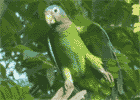
Character of the Month:
Mr. Mike's Lizard-Green Jacket...Deceptively Attractive?
December 2014
Over the past 15 years, I’ve had the pleasure of sharing my living space with some really cute males, none of whom have had hair. They are all as pretty as a rainbow and they go by the formal name of Anolis grahami or the informal name of Graham’s anole. Or, as what most of my Jamaican friends would say: “I don’t care what you call them, how do I get those damn lizards out of my house?!?” But if my friends will bear with me, I hope can convert a few of them to say “Wow, lizards can be kind of cool and quite sexy”.
Jamaica is home to 7 species of lizards which belong to the genus Anolis – we can call them “anoles” for short. Six of these species are endemic to the island -- their natural range is restricted entirely to Jamaica (although humans have moved a few of them to other places). The 7th species, the Cuban brown anole, was accidentally introduced into Jamaica. With the exception of Anolis garmani, the males of which can grow to a whopping 13 cm (measured from the tip of the nose to the point where the tail attaches – we call this “snout-vent length”; then add another 15+ cm for a long tail), all the other anoles on Jamaica are fairly small and will sit comfortably in the palm of your hand.
Of course, Jamaican anoles are so much more than a dull list of species names. Each has a charm, especially if you take the time to gaze into their cute lizard eyes, blinking lazily in the warm sunshine. To see what I mean, let’s go through a day with Anolis grahami and enjoy the Windsor verandah from a lizard’s perspective.
Since it’s December, a lizard’s day doesn’t really start before 7:00 a.m, when it might start peeking out from a safe sleeping perch. But as an ecotherm – an animal which doesn’t generate its own body heat but, instead, relies on the external environment for heating or cooling (I told you our lizards could be cool ☺) -- until the sun crests the hills about 8:30 a.m., there’s not much anole action on the porch. Since the mosquitoes, midges, and other ecothermic insects don’t start buzzing around till the sun starts warming-up the porch, there’s also not much natural food for breakfast…so there’s no point in rising before a civilised hour. And, since Mike and I also are civilised (aka lazy) risers, there’s no human-provided food for breakfast before 8:00 a.m.
Yes, for all my Jamaican friends who thought I was strange, I will now confirm it:
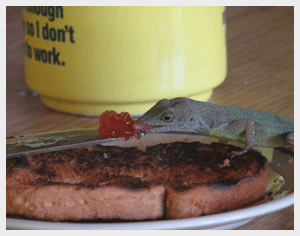 If you don’t chase away, scare, harass, etc. Anolis grahami lizards, they learn very quickly that humans like to eat the same foods that a lizard does. These guys are sugar junkies!
Their natural affinity to lick nectar from plants like passion fruit (Passiflora species) leaves them adapted to love the jams and jellies that we spread on toast.
If you are really patient, they’ll even lick jam from your finger. Although not experimentally evaluated, I think they prefer guava to strawberry jam and they are
definitely less keen on the low sugar, diet raspberry jam. I certainly don’t blame them: I, too, think it’s pointless to eat diet jam
(like decaf coffee and low-fat donuts . . .I mean, really….).
If you don’t chase away, scare, harass, etc. Anolis grahami lizards, they learn very quickly that humans like to eat the same foods that a lizard does. These guys are sugar junkies!
Their natural affinity to lick nectar from plants like passion fruit (Passiflora species) leaves them adapted to love the jams and jellies that we spread on toast.
If you are really patient, they’ll even lick jam from your finger. Although not experimentally evaluated, I think they prefer guava to strawberry jam and they are
definitely less keen on the low sugar, diet raspberry jam. I certainly don’t blame them: I, too, think it’s pointless to eat diet jam
(like decaf coffee and low-fat donuts . . .I mean, really….).
Lunch also is good for anoles on the porch: chocolate chip cookie crumbs, Stilton cheese, sweet gherkin pickles, honey-mustard salad dressing . . . Anolis grahami are like little garbage disposals, cleaning-up my crumby mess in a natural way.
But lunch is no simple affair: being mid-day, sunny and warm, means that the older (larger) males need to make sure that young interlopers don’t try to sneak in and usurp space at: (a) the watering hole (otherwise known as Quarterdog’s old water dish); (b) the table (free food); or (c) heaven-forbid, attempt to sneak a quick copulation with the females while the alpha male is eating some cheese crumbs.
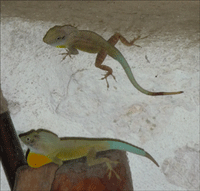 |
| Males assessing each other's size. . . |
| ... and then the fight |
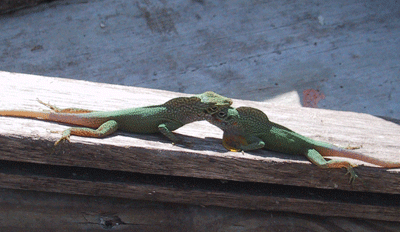 |
Territorial defense is serious business and hierarchies are visible when there are multiple males around. If a small male tries to sneak in, a medium-sized male will start to do push-ups, bob his head, and then extend the dewlap under his chin – all things to make him look bigger than he is (i.e., convince the smaller guy that a fight isn’t worth it). If a female happens to be around, even better for the medium-sized guy (hey, look how strong and fit I am; and look at my bright carrot-orange dewlap, not wimpy-faded like the other guy’s). The largest male watches these displays, but doesn’t waste any energy trying to scare-off the small guy.
When a medium-sized guy decides to take-on a large guy, things heat up: head-bobs, push-ups, dewlaps extending, color change from green to dark brown, lunges…and if two equal-sized males actually make contact and latch on to each other’s throats or the dorsal crests on their necks, there will be vocal squeaks, heaving ribs…all sorts of action, like two wrestlers locked in a full-Nelson. Fortunately for male anoles, they don’t have external ears (pinna) like humans, so there’s no chance of a “Mike Tyson” or "Luis Suarez" nasty attack.
I've never seen a male lose his tail during a fight, so it's actually a rather stylized "battle", no one really gets hurt. Even if a tail-tip did get broken, no problem mon, lizard tails are designed to fall-off when a predator gets a-hold of the tail -- better to lose your tail (and regrow a new one) than lose your life! If you look carefully at the picture of the two males assessing each other's size, you can see the regenerating tail-tip of the male with the extended dewlap.
Of course, with two big guys fighting it out, the smallest guy on the porch has a chance to sneak a quickie with an unguarded female! And, if equal-sized males keep fighting each other (the most intense fight I’ve seen lasted almost 45 minutes), then a smaller guy might even get a chance for a second copulation with another female…because male anoles, like many reptiles, have two penises (called hemipenes) and can switch between right and left when needed. I said lizards were sexy ☺ And, this just goes to show you, you don’t always have to be the big, muscle-bound dude on the beach to impress the ladies.
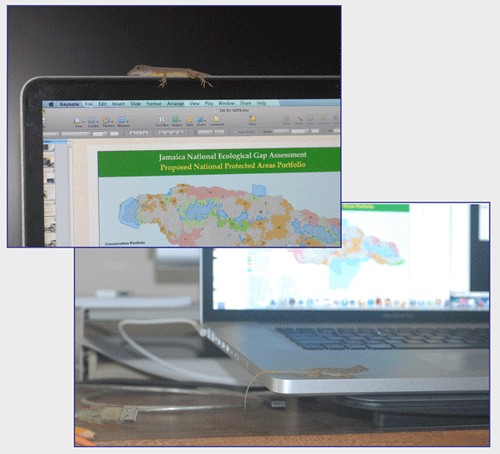 Food…sex…time for an afternoon nap, especially if the afternoon gets cloudy and cool as it does with the 'Northers' in December. Remember, since lizards are ecotherms, cool temperatures
will slow them down….unless, of course, you are a clever lizard living in Windsor. Then you learn that Mr. Mike can be quite productive, happily doing the accounts for hours and
hours and hours on the computer. And computers generate lots of great heat for warming a chilly lizard!
Food…sex…time for an afternoon nap, especially if the afternoon gets cloudy and cool as it does with the 'Northers' in December. Remember, since lizards are ecotherms, cool temperatures
will slow them down….unless, of course, you are a clever lizard living in Windsor. Then you learn that Mr. Mike can be quite productive, happily doing the accounts for hours and
hours and hours on the computer. And computers generate lots of great heat for warming a chilly lizard!
In a normal lizard world, as the sun sets it would be time to find a nice safe place to sleep. In the “real wild” this could be on the end of skinny twig or branch, something that, if a predator were slithering along at night, a lizard would feel the branch move or a slight vibration – enough of a cue to wake up and jump away before getting eaten. On the verandah, safe sleeping perches include segments of PVC pipes, the aluminum poles I use to erect microphones to monitor “ratbat” activity at night, cardboard boxes…all the stuff that human visitors might refer to as “junk”, lizards would say “what amazing structural diversity for us!” It never ceases to amaze me where lizards find to sleep, including vertical walls with no obvious grips. Equally amazing, if a wall proves safe, a lizard will use it night, after night, after night. And always find the exact same spot on the wall.
I said in a “normal lizard world” because in the past 6 months we’ve been watching a weirdo lizard. While all the other lizards are fast asleep after sunset, there’s been one large male on the verandah who not only stays awake past 8 pm but also has been actively hunting moths, behaving more like a nocturnal “croaking lizard” (gecko) rather than a diurnal Anolis lizard. It’s very strange, but shows how clever a little lizard can be.
Sweet dreams to all the sleeping lizards!
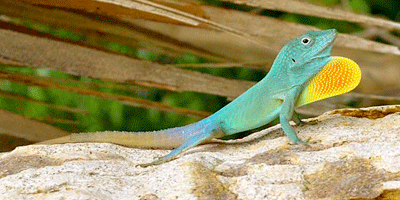 |
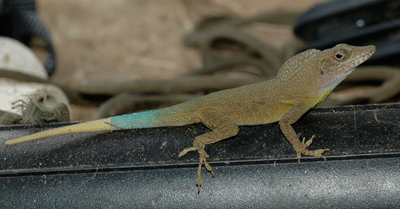 |
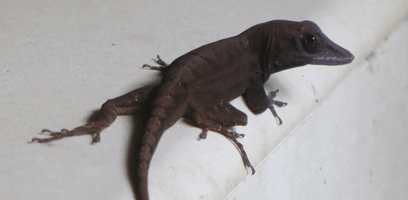 |
With its emerald-to-teal-green body, orange-yellow dewlap, blue-to-violet hind quarters and brown tail, the rainbow we call Anolis grahami is considered to be one of the most beautiful anoles -- wikipedia says this, so it must be true! But some observant readers might say “wait a minute, didn’t I just see a dark brown lizard where the green lizard is now sitting?” Yes, you did!
Anoles are able to change their body colour (= metachrosis) thanks to a neat combination of pigments – pteridines, carotenoids, and melanin-- and structural colours in their layers of skin. Pigments are chemicals that selectively absorb or reflect wavelengths of light: a “green” lizard is absorbing all visible wavelengths except green – that is what is reflected back for you to see, so the lizard would call itself an "anti-green" lizard! The degree to which a pigment absorbs or reflects light can be measured and given as a “Chromatographic R value” – hence the movie rating I assigned ☺.
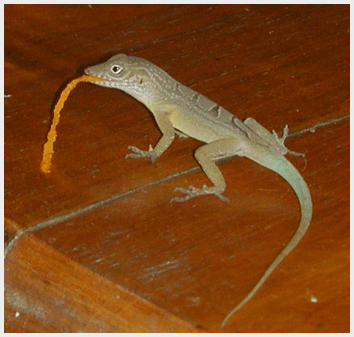 While pteridine pigments are synthesized internally by an animal, carotenoids must be obtained from a diet of plants, fungi, algae and other microorganisms.
Yup, the anoles on our porch also enjoy eating slivers of “Sugarbelly’s carrots” – excellent for maintaining a bright orange dewlap.
While pteridine pigments are synthesized internally by an animal, carotenoids must be obtained from a diet of plants, fungi, algae and other microorganisms.
Yup, the anoles on our porch also enjoy eating slivers of “Sugarbelly’s carrots” – excellent for maintaining a bright orange dewlap.
The body skin of Anolis also contains iridophores – microscopic crystal structures in their scales which scatter light (a similar example are the fine layers of chitin in butterfly wings, which gives them their iridescence). With the angle of incoming ligh, the actual size of the crystal structures, and body positioning, a lizard can “fine tune” the blue-ness of its appearance. In a really neat study of Iberian emerald lizards, which also have these same guanine compounds in their scales, researchers found that male Iberian lizards could maximize their “blue bling” viewed by other lizards perched at their eye level (e.g., other male competitors or potential female mates), while remaining dully-cryptic to someone perched overhead, looking down on them (e.g., an avian predator).
Because of the phenomenon of structural light scattering, the perception of which depends upon the position of the viewer’s eyes, no two people will ever “see” the exact same lizard in identical technicolour – just as no two people can ever see the exact same rainbow!
Underneath the first layers of pigment cells and the iridophores are more specialized pigment cells which contain melanin. In response to low temperatures or other stress, hormonally-stimulated melanosomes expand and migrate to mask the other pigment cells – and we now see a greenish-blue lizard change its colour to dark brown! So, in December, all the lizards on the porch are brown and brownish-green during breakfast, with each individual looking for little patches of sunlight in which to bask. And when adult males get locked into a fierce territorial battle, the guy who stays green the longest (i.e., demonstrating an indicator of fitness by maintaining control of his hormones the longest) remains king-of-the-hill, while the loser scampers away to look for another cookie crumb.
So, don’t laugh at Mr. Mike’s 40-year-old green jacket – it’s a clear example of his long-term fitness.
| PREVIOUS CHARACTER | NEXT CHARACTER |

